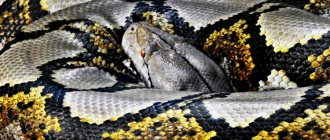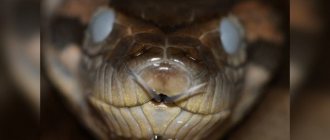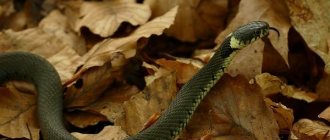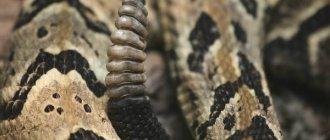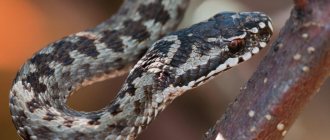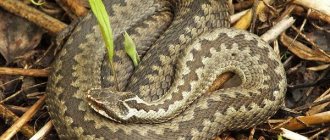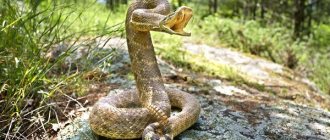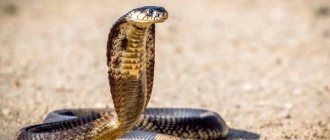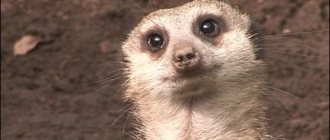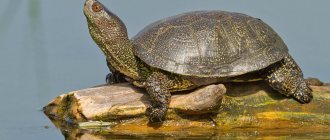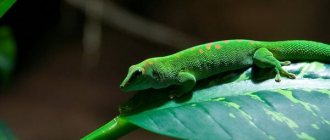Pythons are a family of non-venomous snakes that, due to the remaining rudiments of their legs (like boas), belong to the representatives of pseudopods or boids. They do not have venom glands (or toxins in their saliva), therefore, they do not have large front teeth that are needed for attack.
Animals strangle their victims (smaller mammals), but can also attack small people or in self-defense. A python bite is a rare occurrence both in the wild and in terrarium breeding.
The reader will learn from this article how to avoid unpleasant attacks and what measures should be taken in the event of a snake attack.
Description and features
The python family includes the largest snakes in the world. And not just the big ones. Australian Antaresia perthensis grows to only 60 cm. Not only the sizes of snakes differ, but also their colors.
The color of snakes is associated with the area in which the python lives and hunts. On the skins of some species this is an ornamental, contrasting pattern. The reticulated python in the photo demonstrates the beauty and complexity of the pattern.
Most species have mosaic-like, indistinct spots and stripes on the body. There are monochromatic snakes. There are albino pythons. The white python is more often found in home terrariums than in nature.
In most species, in the area of the lips there are specific sensory organs: labial pits. These are infrared radiation receivers. They allow you to sense the presence of a warm-blooded animal nearby.
The heads of snakes are triangular in shape. The teeth are sharp, curved inwards, ensuring reliable retention of prey. Tree snakes have longer teeth than terrestrial snakes. In addition, arboreal species have a longer and stronger tail.
Python is a snake that has not gone through the entire evolutionary path. Two characteristics can be named because of which the python is considered a primitive, lower snake.
- Vestigial hind limbs, so-called spurs.
- Two lungs.
In higher snakes, hints of limbs are completely lost. As a result of evolution, reptiles from the higher superfamily have only one lung left.
Is python dangerous for humans?
Existing rumors about python attacks on people are exaggerated, although several cases have been officially recognized in which a fourteen-year-old boy and an adult woman became victims of pythons. The reticulated python can be considered potentially dangerous, since recorded cases of attacks on people relate specifically to this snake. But even this python can be more dangerous for a child or teenager than for an adult, since the maximum weight of its prey does not exceed 15 kg. Basically, these large snakes prefer to avoid people and are content only with snatching pets.
The amethyst python crawled into the house. Photo credit: John Hill, CC BY-SA 3.0
Kinds
Determining the type of reptile can be very difficult. Boa constrictors and pythons appear to the layman to be the same species. But they are very distant relatives. They belong to different families.
The main difference is the method of producing offspring: boas are viviparous, pythons are oviparous. The python family includes several genera living in Australia and Oceania. These are small to medium sized snakes.
- Antaresia
Genus of Australian snakes. The length of an adult reptile can vary from 0.5 m to 1.5 m. In addition to Australia, it is found in the east of New Guinea. The genus includes 4 species. Often found in home terrariums. The genus received the name of a star from the constellation Scorpio in 1984 during the next revision of the biological classifier.
- Apodora
This genus includes one species. He lives on the island of New Guinea. The snake is quite large. From 1.5 m to 4.5 m in length. Hunts in the darkness of the night. The color of the skin is olive or brown. Various transitional options are possible: dark brown back, yellow-brown sides, and the like. It tolerates life well in terrariums.
- Aspidites
The second name of this species of snake is black-headed python. The yellow-brown body with transverse stripes is crowned with a black head. Found in northern and central Australia. Its habitat is forests, fields covered with bushes, and plains from Queensland to Cape Leveque.
- Bothrochilus
Snakes of this genus are called white-lipped pythons. Grows up to 2-3 meters in length. The body is colored uniformly. The color depends on the habitat. There are different options: gray, almost black, brown, yellow. Intermediate variations are possible.
- Liasis
A genus of pythons with five living species and one fossil - Liasis dubudingala. It was a giant snake. Its length reached 10 meters. Lived in the early Pliocene.
- Morelia.
This species includes 4 species. In the recent past, it included 7 more species. The snakes included in the genus are called diamondback pythons.
- Python
This is a genus of true pythons. In their myths, the ancient Greeks called the snake guarding the entrance to the place where divinations were announced. The so-called Delphic oracle. The snake not only guarded the oracle, but also devastated the surroundings of the city of Delphi. The god Apollo put an end to the excesses of the snake: he killed the giant reptile.
Large snakes lived in Europe. Having examined their remains, scientists recognized that this is a species of fossil European pythons from the genus Python. They existed during the Miocene era. They became extinct during the Pliocene period, approximately 4-5 million years ago. The genus of true pythons includes 11 species.
- Dwarf python. A snake not exceeding 1.8 meters. Lives in Angolan and Namibian fields overgrown with bushes. The main habitat gave the reptile its second name - the Angolan python.
- Tiger dark python. A large snake up to 5 meters in length and 75 kilograms in weight. It lives in the southeastern regions of Asia and on some islands of Indonesia.
- Breitenstein's pied python. Lives in tropical rain forests of southeast Asia. An adult grows up to 2, rarely up to 3 meters. This snake is distinguished by a short tail and a thick body.
- Red spotted python. The snake is a resident of Asia. In the southeast of the continent it has developed rainforests. Visits agricultural plantations. Can live in the foothills, up to an altitude of 2000 meters. Characterized by a wide variety of colors.
- Short-tailed python. The name reflects the peculiarity of the body structure: the snake has a short tail and a large body. Grows up to 3 meters. Inhabits Indonesia: the islands of Bali, Sumatra and Belting. Found in Vietnam and Thailand.
- Tiger python . Thrives in the southeastern regions of Asia, on the islands of Indonesia. Mastered various landscapes: wet forests, swampy meadows, bush thickets, foothills.
- Ethiopian python. The name is given by the country in which it is often found. But it inhabits not only it. It is observed in regions south of the Sahara. The length of the reptile varies from 3 to 6 meters.
- Royal python . Inhabitant of forests, river valleys and savannas of Western and Central Africa. One of the smallest species. It does not exceed 1.3 meters in length. In case of danger, it curls into a ball. Therefore, it is often called a ball python, or ball.
- Hieroglyphic python. The snake is also called python seba. In honor of the Dutch zoologist Albert Seb. There is a third name: rock python. This resident of Africa can grow up to 6 meters or more in length. One of the longest snakes found in Africa.
- Reticulated python. Lives in Hindustan and the Korean Peninsula. Settled on the islands of Indonesia and the Philippines. It is considered one of the largest snakes. Some zoologists, especially in the past, have reported amazing sizes exceeding 10 meters. In reality, specimens that reached 7 meters in length were observed.
In 2011, the species of real pythons was supplemented by Python kyaiktiyo, endemic to one of the regions of Myanmar.
Keeping a python at home
Pythons are non-venomous, beautiful and generally calm and peaceful snakes. Previously, they were kept only in zoos. Now some hobbyists keep pythons at home, purchasing different types for home terrariums. These can be the very popular tiger pythons, large reticulated pythons, and other varieties.
Terrarium
Large snakes need large spaces. The size of the housing is selected depending on the type of future occupant. The perimeter of the terrarium should be at least 2 times the length of the snake. It should also be taken into account that a python, especially a large one, is a strong snake that, when thrown, can pierce or squeeze out glass or plastic several mm thick. Therefore, the design of the terrarium and the thickness of its walls must be carefully selected. The top must be covered with a lid with ventilation holes. As bedding at the bottom of the terrarium, you can use paper towels, newspapers, artificial substrate, but not sawdust. Pythons love to climb trees, so their house should contain branches or snags, but such that it will not get hurt.
Temperature and humidity
Southern heat- and moisture-loving pythons need an appropriate habitat. The temperature in the terrarium should be maintained around 25-27 °C, and at the warming point 30 °C or more. The heat source is turned off at night. You don't have to turn it off, but then the snake needs to have a place where it can cool down. In the snake house, it is mandatory to install drinking bowls and mini pools with fresh water necessary for drinking, swimming and maintaining humidity around 90%.
Feeding a pet python
Domestic pythons are fed as they grow, first with mice, hamsters, rats, then chickens, rabbits. To avoid injury to reptiles, it is best not to feed them live animals. Young animals are given food approximately once every 5-7 days, adults - once every 10-14 days.
Photo by: Chomelka, CC BY-SA 4.0
Lifestyle and habitat
A warm and humid climate is the main condition for the existence of pythons. They can live in tropical forests, swamps, open and bushy grasslands, and even rocky outcrops and dunes.
Pythons brought to North America found themselves in a favorable environment. They didn’t have to change their habits and adapt for a long time. The nature of the Florida Everglades fully corresponded to the climatic and landscape preferences of pythons.
Some species of pythons are skilled at climbing trees. Almost everyone is a good swimmer. But not one type can be called high-speed. Pythons stretch forward. The front part of the body rests on the ground. The middle part of the body and tail are tightened. The front part of the body is pulled forward again.
This method of snake movement is called rectilinear. It is characteristic of large species of snakes. The movement speed is low. Approximately 3-4 km/hour. Over a short distance, a large python can reach speeds of up to 10 km/h.
The beauty, predatory nature and mystery inherent in snakes have made pythons frequent inhabitants of home terrariums. The royal, also known as the yellow python, is a popular species among connoisseurs and amateurs.
Python molt
Like all snakes, pythons shed. The frequency of skin changes depends on many factors: the snake’s nutrition, general condition, living conditions. Juveniles molt frequently, approximately every 2-4 weeks. With age, the number of molts decreases to once every few months. When molting, the python's skin peels off from the front of the head, and then, like a stocking, is removed from the entire body. A sign of approaching molting is clouding of the skin, and then the eyes. During this period, the python does not eat anything and is in an unstable state, easily excited. You should not feed or irritate him at this time.
Python molts
Nutrition
Pythons are exclusively carnivorous. Various animals become prey. It all depends on the size of the snake. Small species and young snakes are content with rodents, lizards, and birds. The diet of large individuals includes monkeys, wallabies, antelopes, and wild pigs. Livestock can also become a hunting trophy for pythons.
Pythons ambush animals. The trap for prey is set up in different ways: among tall grass, in trees, partially immersed in water. The main task of the hunter is to sink his teeth into a careless animal or bird with a throw. Next, he wraps rings around it and squeezes it. The prey's breathing and blood circulation stop. The python proceeds to swallow the killed trophy.
The snake's jaws can be opened as wide as desired. This allows a large animal, such as an adult antelope, to be swallowed whole. After swallowing, the python crawls away to a place that is safe, from its point of view. Moves on to digesting lunch. Zoologists say that snakes of this genus can go without food for up to one and a half years.
Pythons prey on herbivores and predators of various types and sizes. In areas where crocodiles or alligators are found, even these reptiles can be strangled and swallowed. But there is another side to the coin. Snakes themselves suffer from predators. In Australia from the same crocodiles, in Africa from big cats, jackals, large birds and other predators.
National Geographic magazine reported in June 2022 about a tragic incident in Indonesia. A python attacked a 54-year-old woman working in her garden. The fate of the peasant woman turned out to be sad. A year earlier, in the same places, a reticulated python attacked a young man and swallowed him.
Enemies of pythons in nature
Due to their large size, pythons have few natural enemies. Young pythons can become victims of birds of prey and mammals. Sometimes snakes can be attacked by animals that are their constant food. For example, a pack of jackals can surround and mortally wound a large hieroglyphic python. The main enemy of pythons is humans. In many habitats, people eat them or use their skin to make shoes, clothing and other items.
The alligator caught a dark tiger python. Photo credit: Lori Oberhofer, Public domain
Reproduction and lifespan
At the age of 5-6 years, pythons are capable of reproduction. The desire to procreate is determined not only by age and calendar season, but also by the availability of food. A sexually mature female communicates its readiness for reproduction with the help of pheromones.
The male finds her following the scent trail. Snakes rub against each other. The male uses the rudiments of his hind limbs to massage the body of his partner snake. The result of mutual stimulation is mating.
All types of pythons are oviparous. The female prepares a nest - a cup-shaped depression in the ground or rotten wood. 2-3 months after mating, a clutch is laid. It consists of a large number of leathery eggs. Record clutches reach 100 eggs, usually the case is limited to 20-40 eggs.
The female guards the clutch. Despite their cold blood, pythons manage to warm their offspring enclosed in a shell. As the temperature drops, the snake's muscles begin to contract quickly and finely and tremble. The effect of so-called contractile thermogenesis is triggered.
The female does not eat during the entire incubation period. The male does not participate in this process. After two months, young pythons are born. Parents do not take part in the future fate of their offspring. With a successful combination of circumstances, pythons can live 25-35 years.
Interesting facts about pythons
- Some scientists suggest that animals that fall prey to pythons and boa constrictors die not from lack of air, but from circulatory arrest. The snake strangles the victim and at the same time listens to how its heart beats. After the heart stops, they loosen their death grip. In this way, snakes save calories spent on the work of strangling the animal.
- In the USA, a special sensor was developed that measures the force with which the python squeezes the victim. It turned out that an individual 5.5 m in length exerts a pressure of 1 kg per 1 cm2, which is 6 times more than the pressure with a strong handshake.
- At the zoo, you can observe how a hungry python reacts to people approaching the terrarium, while a well-fed one does not show any interest in them.
- A python that has been constantly fed white rats and rabbits develops a reflex to the color white. As a result, the hungry snake reacts to the white clothing of visitors or zoo staff.
Photo credit: Tigerpython, CC BY-SA 3.0
Did you like the article? Share with your friends:
